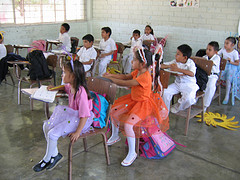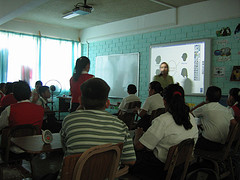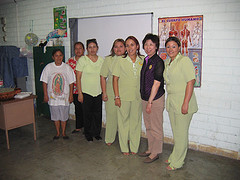Promethean World Interactive Whiteboards
Promethean | Promethean Ambassadors | IWB Project | Press Release | Interim Report |Findings
 Monterrey
Workshop: Findings from the first year of the MirandaNet/Promethean Ambassadors
project
Monterrey
Workshop: Findings from the first year of the MirandaNet/Promethean Ambassadors
project
Improvements | Changes in classroom dynamics | Changes in learning | CPD | Conclusions
The teacher-researchers and university researchers have been collecting data since the project started in 2005. By the end of the first twelve months of the project, in March 2006, evidence was building from schools in all four continents – China, Mexico, South Africa and the United Kingdom – that ACTIVboards were acting as a catalyst for change in learning and teaching.
Improvements
 Punctuality
Punctuality
Teachers from Mexico, China and the United Kingdom report that, in classes
where ACTIVboards are used, punctuality has improved. Pupils arrive at school
on time, and arrive at lessons on time. This improves the learning environment
and demonstrates the way in which pupils become more involved with their own
learning. Time on task increases.
Attendance
In the Ambassadors’ schools in Mexico and the United Kingdom pupil attendance
can sometimes be problematic. The advent of ACTIVboards for teaching and learning
has seen a dramatic improvement in attendance, particularly for young males.
Their involvement in the learning process provides a raison-d’être
for attending school. This is particularly strong in the schools in Monterrey,
Mexico, where pupils attend the afternoon sessions of a two-shift school system.
Attention and time on task
“Teaching is getting more clear, interesting and direct using ACTIVboards
in the lesson.
Facilitating the storage, communication, recomposition of data and discussion
with data.
Operating IWBs can promote students’ ICT ability and information
literacy.” (Chinese students, Grade 11.)
“My pupils groan when the bell goes at the end of a lesson.”
(Teacher, South Africa)
Motivation
Teachers from all four countries commented on increased motivation of pupils.
Evidence to support these observations came from reluctance to leave the classroom
at the end of the lesson to the desire to use the ACTIVboard during breaks
and at the end of the school day. Classroom videos show total engagement of
the whole class.
Changes in classroom dynamics
 Whole-group
participation
Whole-group
participation
In previous studies (Cuthell 2002 & 2003) some non-teachers have commented
that classrooms with interactive whiteboards seemed no more interactive than
those without. The teacher is seen to be the one who hands the pen to a pupil,
who performs an operation and then returns the pen to the teacher. Indeed,
Glover and Miller (2005) comment that in some cases the use of an IWB can
be seen to reinforce the traditional didactic role of the teacher, and this
comment has been used to undermine the potential of the boards.
Evidence from these global studies, however, suggests that there is whole-class involvement in the process of learning when a pupil is at the board undertaking a task. All of the pupils participate in the classroom dialogue and all participate in the learning process. This is supported by an increasing data set of video evidence.
Independent learners
The impact of ACTIVboards on classrooms has seen a change in the culture of
learning. Control has shifted from the teacher, as arbiter of content, learning
and outcomes, to the pupils, who manage their own learning and are no longer
dependent.
Promoting the interactivity and communication in class, and the operating IWB by students themselves makes the comprehension of knowledge easier.
Chinese students said that they would like to study and organise discussions by the students themselves such as speeches, group study, class meetings and so on.
They also wanted to use the ACTIVboards to solve problems and enlarge knowledge by students themselves.
Pupils manage their own learning
The use of digital tools by pupils to prepare work for presentation to peers
means that many of the processes are undertaken collaboratively. Pupils are
not only learning about the content of the lesson, but also the process of
producing the materials and the pedagogy of presenting it. They therefore
become much more aware of the learning process, both for themselves and others.
Learning for these pupils – from six-year olds through to 18-year olds
– changes them from what McGregor (1960), in ‘The Human Side of
Enterprise’, termed ‘Theory X’ workers, who need to be checked
and supervised at every stage, because they feel no involvement in the process,
to ‘Theory Y’ workers. To transform McGregor’s observations
about adult workers to the classrooms of the Knowledge Society:
“If a job is satisfying, then the result will be commitment to the organization;
The average pupil learns, under proper conditions, not only to accept but to seek responsibility;
Imagination, creativity, and ingenuity can be used to solve problems by pupils;.
Under the conditions of most classrooms, the intellectual potentialities of pupils are only partially utilized.”
Who’s the teacher, who’s the learner?
“We find teaching with the white board is very different and a number
of adaptations needed to be made to our lessons. … Once we changed tactics
to suit the technology, however, the lessons improved.”
One of the most significant shifts in the ecology of the classroom is the changing role of the pupils. They now prepare work in digital formats and present it to their peers, who follow up the presentation with questions. This achieves a number of objectives: the work is seen as ‘real’, in that it is being presented to an authentic audience, which means that the production values become important, both for the presenter and the audience. Pupils must master their subject, because their peers are likely to ask challenging questions. The collective learning experience for the whole class is enriched, in that a much wider range of topics is covered than in conventional class- and homework.
Pupils become competent in the use of the ACTIVboard and ACTIVstudio, which is used for producing flipcharts. Their exposure to, and experience of, the technology is greater than that of most of their teachers. They are therefore able to act as mentors to teachers who are learning to use the technology themselves.
Changes in learning
Increased productivity
All of the schools have seen pupils cover more curriculum material and produce
more work. Time on task increases: pupils feel engaged by ‘real’
tasks and therefore work for longer. If increased production is seen as important
and required by the school, then this is likely to be one of the immediately-realised
targets for both pupils and teachers.
Faster learning
The affordances of the boards – through visual learning, pupil input,
group collaboration – mean that pupil learning is faster and initial
assessment suggests that retention and transfer is particularly improved.
This has been noticed with all of the classes, from six-year olds in South
Africa to 18-year olds in China actively engaged in using English to present
work to their peers.
Evidence from prior MirandaNet research in the United Kingdom reinforces these initial findings (Graham, 2003; Lowe, 2003)
More effective learning
Pupils work harder for an audience or authentic task than they do for a grade.
Self-direction provides the scaffolding for pupils to test their learning
models and relate them to those of their peers, through the whole constructivist
cycle of learning.
Awareness of the learning process
Collaborative work and discussion reinforces awareness of the learning process.
Ostensiveness - pointing at objects on the ACTIVboard, using the pen, reinforces
learning. Visualization enables learners to recall the stages of learning,
either in the classroom, using the board, or subsequently, recalling through
visual memory, either individually or collectively. All of the students surveyed
state the extent to which Ludic elements are important. Learning becomes fun
– and memorable because of this.
Collaborative learning
All of the classrooms in the project have demonstrated the extent and power
of collaborative learning. The teacher is no longer the sole focus of attention:
the class use the ACTIVboard as their focal point, and this objectification
of the learning process changes the right/wrong, correct/incorrect paradigm
of so much learning. Where groups, or the class, are collaborating the success
is collective – and the ways in which the boards are used show that
pupils will work until all are satisfied with the result.
Continuous Professional Development for Whole-School Improvement
 Changes
in pedagogy
Changes
in pedagogy
All of the classrooms in the study show changes in pedagogy. There is a much
greater awareness on the part of teachers of individual learning needs, and
the ways in which these can be accommodated through the software. The structure
and timing of the lesson, and the role of pupils within it, have changed the
role of the teacher from a didactic one to a learning manager, where the process
of learning and understanding guides and shapes the presentation of content.
Focus on individual learning needs
All of the teachers have found that the ability to create materials provides
opportunities to support a range of learning needs and styles. With saved
flipcharts pupils can revise previous lessons; they can use ACTIVstudio to
create their own lessons – a process which embeds understanding and
learning in a highly powerful way. The use of consolidation materials with
individuals and small groups has raised attainment in the foundation stage
of school with literacy and numeracy, and with oral and presentation skills
with Chinese high school students.
Enrichment of curriculum materials
The curriculum resources supplied as part of ACTIVstudio, together with a
range of digital tools (such as Inspiration) and internet resources, have
transformed the presentation of curriculum materials.
Pupils in all of the schools have commented that the boards enable them to see materials more clearly, and the visual resources transform the learning experience, particularly in subjects such as Science, Geography and Mathematics.
Staff collaboration
Staff work together to learn skills and discuss their pedagogical application,
which has led to a greater understanding of the ways in which their pupils
learn.
The most significant element, though, is the sharing of material and the discussion of common ways in which pupils can be supported and developed in their learning.
The traditional school structure, with teachers isolated in individual classrooms with their classes, is changing to one in which the school is becoming seen as a learning organisation, with all the stakeholders – pupils, teachers, administrators, families and the community – involved in the process of transforming education and transforming lives.
Embedding e-learning into the curriculum
What do ACTIVboards do to a classroom, to teaching and to learning? They open
a window through which the wider world can be brought into the classroom.
Pupils in Sunderland can work collaboratively to arrange and organise a symphony
orchestra. Children in inland Mexico can watch high-definition digital video
of blue whales from BBC resources; pupils in China can present work on the
effects of Hurricane Katrina, using images from weather satellites and newscasts;
a pupil in South Africa can explain to her classmates the breeding cycle of
a Great White Shark.
Conclusions
At the end of the first year of this project all of the schools and researchers report significant changes in the school, in classroom organisation and in the learning process. Research summaries in 2005 by Glover, Miller, Averis & Door, and by Smith, Higgins, Wall & Miller, have suggested that the small-scale studies showing the impact on schools, on classroom management and pedagogy tended to be anecdotal and restricted to individual classrooms.
The Ambassadors research project shows that, in a global study, these are precisely the impacts that can be observed, recorded and analysed. The evidence from this project is not anecdotal. It is not small scale.
Managing change is key to the success of the project. All of the participant institutions have seen the project as an opportunity to re-examine the role of the school, the teacher and the impact on teaching and learning.
Use of the ACTIVboard and ACTIVstudio leads teachers to a deeper understanding of pupil learning styles, and the ways in which the boards can support these. Teachers see that their own preferred learning style is not necessarily one that accords with all of their pupils, and the software and digital resources generate insights into other ways of knowing that their pupils may have.
This research has conclusively demonstrated that concerns that IWB use is ‘just another presentational tool’ are unfounded. Whilst this may be the case if the institution and its teachers simply use the IWB as a £5,000 blackboard, it still means, in the words of one UK pupil, “If your teacher’s no good you can at least see what they were supposed to be teaching you.”
The Promethean Ambassadors programme has conclusively demonstrated the changing pupil/teacher participation patterns in the project schools. It is difficult to think of another technology that would have presented all of the affordances that made these possible.
Read the Report on the Monterrey Workshop
Read Promethean's Report on the Findings
[Back]
